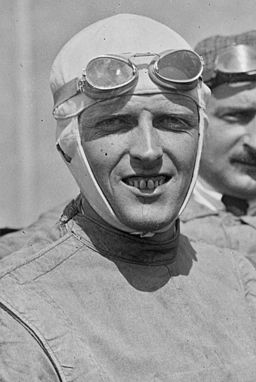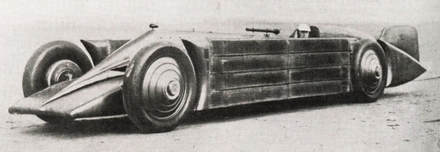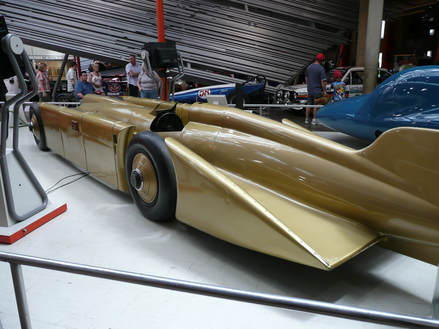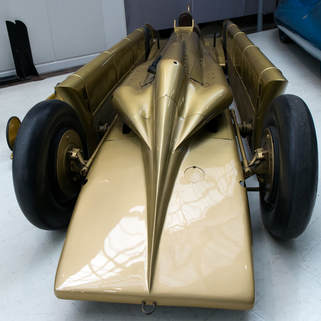 Sir Henry Segrave
Sir Henry Segrave
On March 11 of the year 1929, the Golden Arrow, driven by the British race car driver, Sir Henry Segrave, set a new land speed record of 231.45 miles per hour at Daytona Beach, Florida. The Golden Arrow was designed by "Captain" John Samuel Irving, who had earlier designed the dual-engine Sunbeam "Mystery" (or "Slug"), which was the first car to break the 200 mph barrier in 1927, with a speed of 203.79 miles per hour. Henry Segrave had also driven the Mystery on its record-breaking run.
Less than a year after Segrave set the land speed record in the Sunbeam Mystery, the record was broken by the American, Ray Keech, driving the triple-engine "White Triplex", which was owned by J.H. White, a wealthy American determined to wrest the land speed record from the British. Keech, however, was injured while setting the record in the White Triplex and considered the car to be unstable and dangerous.
The Golden Arrow was specifically designed to regain the land speed record from the Americans. Originally, Irving designed the car for a top speed of 274 mph, but later scaled it back to 240 mph because the manufacturer of the tires, Dunlop, would not guarantee the safety of its tires beyond 250 mph. Moreover, Irving had to use a less powerful engine and fuel than he wanted to, due to pressure from his sponsors. Nonetheless, the engine and fuel Irving ended up using was able to generate more than 912 bhp, which was more than the 900 bhp that was generated by both engines in the Sunbeam Mystery. The engine Irving used was a 23.9 liter W12 Napier Lion VIIA airplane engine, which was a twelve cylinder internal combustion engine having the pistons arranged in three banks of four cylinders to form a W-shape.
Since Irving would be using only slightly more horsepower in the Golden Arrow than he had used in the Sunbeam Mystery, Irving decided to rely on improved aerodynamics to achieve increased speed. This decision was in contradistinction to the White Triplex which relied on brute power (an estimated 1500 bhp) to achieve its land speed record over the Sunbeam Mystery.
The Golden Arrow was heavy (7,814 lb), long (about 27.5 feet), narrow (about 6.3 feet) and low-slung, being just 43" high and as close as 6 inches to the ground at certain points. The bodywork of the Golden Arrow included a sloping front fairing for translating wind pressure into a downwardly-directed force on the front axle and a large tail fin for providing stability against cross-winds and extra weight on the rear axle. The bodywork, as a whole, was shaped to exert downward air pressure to keep the wheels on the ground and provide stability. In this regard, the Golden Arrow used "ground effect" more than forty years before it was widely adopted in racing.
While the Golden Arrow was aerodynamic and stable to drive, it was difficult to steer because the field of vision for the driver was greatly limited by the long front end and low seat position of the driver. In order to remedy this deficiency, the Golden Arrow was provided with two rifle sights, one with cross-wires located on the nose of the car and a naked sight located just in front of the driver. When making his record-breaking run, Segrave maintained his position on the course by aligning the rifle sights with red arc lamps strung along the length of the course.
Segrave established his land speed record in the Golden Arrow with relative ease. He only had one practice run and then made the requisite two runs to establish the record. In each of the two runs, it took Segrave three miles to establish top speed for the one-mile measured distance and then another three miles to bring the Golden Arrow to a full stop.
Less than a year after Segrave set the land speed record in the Sunbeam Mystery, the record was broken by the American, Ray Keech, driving the triple-engine "White Triplex", which was owned by J.H. White, a wealthy American determined to wrest the land speed record from the British. Keech, however, was injured while setting the record in the White Triplex and considered the car to be unstable and dangerous.
The Golden Arrow was specifically designed to regain the land speed record from the Americans. Originally, Irving designed the car for a top speed of 274 mph, but later scaled it back to 240 mph because the manufacturer of the tires, Dunlop, would not guarantee the safety of its tires beyond 250 mph. Moreover, Irving had to use a less powerful engine and fuel than he wanted to, due to pressure from his sponsors. Nonetheless, the engine and fuel Irving ended up using was able to generate more than 912 bhp, which was more than the 900 bhp that was generated by both engines in the Sunbeam Mystery. The engine Irving used was a 23.9 liter W12 Napier Lion VIIA airplane engine, which was a twelve cylinder internal combustion engine having the pistons arranged in three banks of four cylinders to form a W-shape.
Since Irving would be using only slightly more horsepower in the Golden Arrow than he had used in the Sunbeam Mystery, Irving decided to rely on improved aerodynamics to achieve increased speed. This decision was in contradistinction to the White Triplex which relied on brute power (an estimated 1500 bhp) to achieve its land speed record over the Sunbeam Mystery.
The Golden Arrow was heavy (7,814 lb), long (about 27.5 feet), narrow (about 6.3 feet) and low-slung, being just 43" high and as close as 6 inches to the ground at certain points. The bodywork of the Golden Arrow included a sloping front fairing for translating wind pressure into a downwardly-directed force on the front axle and a large tail fin for providing stability against cross-winds and extra weight on the rear axle. The bodywork, as a whole, was shaped to exert downward air pressure to keep the wheels on the ground and provide stability. In this regard, the Golden Arrow used "ground effect" more than forty years before it was widely adopted in racing.
While the Golden Arrow was aerodynamic and stable to drive, it was difficult to steer because the field of vision for the driver was greatly limited by the long front end and low seat position of the driver. In order to remedy this deficiency, the Golden Arrow was provided with two rifle sights, one with cross-wires located on the nose of the car and a naked sight located just in front of the driver. When making his record-breaking run, Segrave maintained his position on the course by aligning the rifle sights with red arc lamps strung along the length of the course.
Segrave established his land speed record in the Golden Arrow with relative ease. He only had one practice run and then made the requisite two runs to establish the record. In each of the two runs, it took Segrave three miles to establish top speed for the one-mile measured distance and then another three miles to bring the Golden Arrow to a full stop.
 Bible driving the White Triplex
(from the Florida Memory Project)
Bible driving the White Triplex
(from the Florida Memory Project)
After the Golden Arrow broke the White Triplex's previous land speed record, J.H. White was determined to win the record back from the British. He tried to convince Keech to again drive the White Triplex in an effort to break the Golden Arrow record. Keech, however, refused to do so, believing that the White Triplex was too dangerous. Undeterred, White found another driver, Lee Bible, who agreed to drive the White Triplex at Ormond Beach on March 13, 1929. On his third attempt to break the Golden Arrow record, Bible crashed the White Triplex at more than 200 mph, killing himself and a photographer. After witnessing the horrific crash, Segrave vowed to never again attempt to break another land speed record. He kept his vow, but, unfortunately, continued to race boats, which led to his death in 1930.
In 1958, the Golden Arrow was donated to the (British) National Motor Museum at Beaulieu, where it is currently on display (see below). It has only 18 miles on its odometer.
In 1958, the Golden Arrow was donated to the (British) National Motor Museum at Beaulieu, where it is currently on display (see below). It has only 18 miles on its odometer.
Proudly powered by Weebly





